|
The seafood we offer to predatory pets like large fishes, axolotls and
predatory turtles cannot always compete with their natural diet in terms of
variation and freshness.
Because we mostly feed our pets frozen foods, we need to consider any
biochemical differences between their natural diet and their captive diet. The
freezing and thawing processes can result in deficiency diseases in the long
run, and if this is exacerbated by poorly chosen food items, the result is that
our pets will enjoy a shortened lifespan.
In particular, one problem often discussed in the context of feeding
predatory animals is the presence of the enzyme Thiaminase in many types of fish
and invertebrates. While strong and often controversial opinions on this topic
have been voiced among pet owners, there is a distinct lack of solid
information. It is the intention of this article to summarize what is known
about Thiaminase and the related deficiency disease, which can be relevant for
pet fish nutrition.
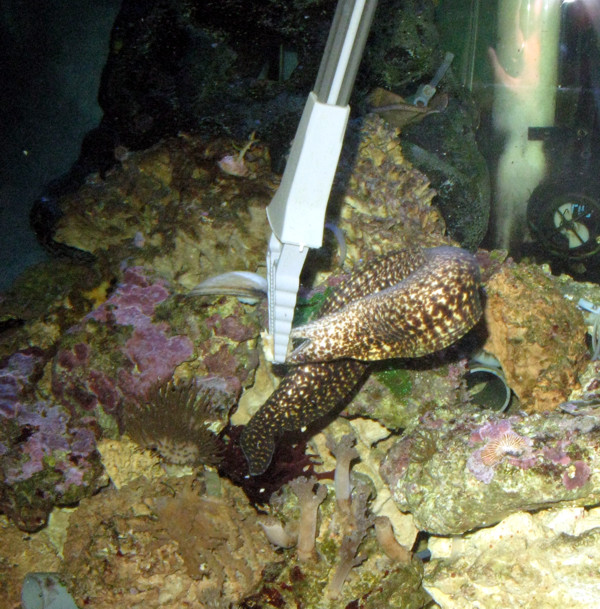
"Predatory fishes like this moray eel need a
fishy diet, but not all foods available in trade are equally safe with
regard to their Thiaminase content."
What is Thiaminase?
Thiaminase is an enzyme, a chemical compound that destroys or
inactivates thiamine. Thiamine is an important vitamin also known as Vitamin B1.
There is not just one type of Thiaminase, but several different ones, some of
which can be produced by bacteria, fungi, plants and potentially animals.
The lack of Vitamin B1 in humans is called beriberi.
Thiamine Deficiency Syndrome and its symptoms
Vitamin B1 (also known as thiamine, thiamine
hydrochloride, and in older text books, as aneurine
hydrochloride) is an essential nutrient for most animals. It is a
colorless and water soluble chemical that helps to convert carbohydrates into
glucose. It is particularly important for the correct functioning of the nervous
system. A lack of Vitamin B1 is called a Thiamine Deficiency Syndrome.
Symptoms of this syndrome are well known from several commercially
important fish groups and can be confirmed using appropriate biochemical tests.
Flatfish fed exclusively with Thiaminase-rich clams suffer and die from
paralysis and related physical shocks. Eels show a trunk-winding syndrome and
hemorrhages along the base of the fins (similar symptoms have been reported from
moray husbandry, too). Salmonids show nervous disorders, poor appetite, poor
growth and jumpiness (again, similar things have observed among a variety of
ornamental fish species). Skin congestion and haemorrhage have been reported
from carp and other cyprinids. In general then, excessive amounts of Thiaminase
are connected with symptoms of sickness that include poor growth, loss of
appetite, abdominal swelling and hemorrhage, loss of equilibrium, convulsions,
muscle atrophy and a weak immune system.
While it has not yet been scientifically proven that pet fish suffering
from the above mentioned symptoms have Thiamine Deficiency Syndrome, the
parallels with their food fish relatives are striking. The problems of
Thiaminase are now well known in the professional fields of animal nutrition
(e.g. fish farms), but so far this information has not been widely taken up by
aquarists and pet owners. But it is clear that those hobbyists keeping large
predatory fish and other carnivorous animals need to be familiar with the
problem of Thiamine Deficiency Syndrome, and use that information to make
sensible choices when selecting food for their livestock.
Aren't Thiaminase containing fish eaten in the wild?
Yes, they are, and this can cause predatory fish massive problems. The
offspring of salmon from the Baltic Sea -- which apparently feed mostly on
Thiaminase-rich herring and relatively little food that contains high levels of
Vitamin B1 -- were found to suffer from a condition called Reproduction Disorder
M74. This was later identified as being simply one particular form of Thiamine
Deficiency Syndrome. The eggs produced by adult salmon were provided with very
little thiamin, and the fry that emerged almost all died soon after hatching.
Comparable problems have been found among Salmonids in the Great Lakes of North
America, and this has been hypothesized to be related to a diet containing a
large proportion of alewives, another type of Thiaminase-rich fish.
However, most of the time predatory fishes maintain a kind of balance
between those prey fish rich in Thiaminase and those fish rich in Vitamin B1. As
long as the predator has a reasonably varied diet, it should get enough Vitamin
B1 to stay healthy. It should be mentioned that in the examples of the sick
Salmonids from the Baltic, the key problem was that they were not eating a
varied diet, but mostly consuming just one type of prey.
The big problem for captive fish is that they are fed frozen fish.
Thiaminase is not destroyed by freezing, and over time will break down whatever
Vitamin B1 is present in the frozen fish. The longer the fish is stored, the
less Vitamin B1 it will contain. Furthermore, any fish fed such frozen fish will
be consuming the Thiaminase, and that will destroy some of the Vitamin B1 it
already has. Making things even worse, freezing and thawing both break down some
of the Vitamin B1 content of food as well.
While freezing does not destroy Thiaminase, heating it will. This is why
cooked fish is not dangerous with regard to Thiaminase for human or animal
nutrition. From the perspective of a fishkeeper, the big drawback to cooking
food is that heating destroys a lot of the useful nutrients as well. While
omnivorous humans compensate for that by eating a varied diet containing both
raw and cooked plant and animal foods, piscivorous fish have no such option.
They cannot be fed cooked fish and expected to stay healthy.
At least some types of live feeder fish will contain more Vitamin B1
than frozen foods, but the downside here is that the convenience of live foods
is accompanied by a major risk of introducing pathogenic microorganisms such as
Mycobacteria and endoparasites. Feeder fish are also expensive compared with
frozen foods, and as will be described shortly, many of the types of feeder fish
widely sold contain a great deal of Thiaminase anyway, dramatically reducing
their usefulness.
Which fish and other food of aquatic origin contains Thiaminase?
A common generalisation often made by aquarists is that marine fish
don't contain much Thiaminase while freshwater fish do. This is not the case at
all.
From my review of the literature, of the 32 species of freshwater fish
tested, 18 of them were found to contain Thiaminase. Among the 61 marine fish
tested, 32 were found to contain Thiaminase. In other words, 56% of the
freshwater fish examined contained Thiaminase compared with 51% of the marine
fish species. If there is a difference between freshwater fish and marine fish
in terms of Thiaminase content, any such difference appears to be rather small.
Among the food fish families consumed by man, species that contain
Thiaminase include minnows, carps, herrings, anchovies, goatfishes and snappers.
Many different invertebrates have also been found to contain Thiaminase,
including mussels, clams and shrimps/prawns such as those in the genus
Penaeus, sometimes in even higher concentrations than those found in fish.
In contrast several groups of fish have been generally found to be free
of Thiaminase, including North American sunfishes, flounders, cods and croakers.
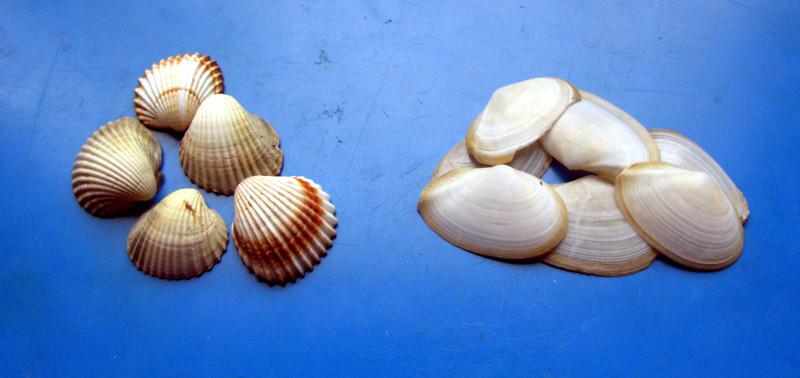
"Bivalves such as clams can are a good food within a varied diet, but many
contain a lot of Thiaminase and
should not be used exclusively; some however, notably cockles, contain
little Thiaminase and are consequently a better all-around food for
mollusk-feeding predators such as pufferfish."
Thiaminase content review
The data on Thiaminase content comes from various sources, mostly from
the National research council (1982), Deutsch & Hasler (1943), Greig &
Gnaedinger (1971) and Hilker & Peter (1966); see also the literature list at the
end of the article. The lists are far from complete, but most of the usually
marketed and so far examined species are enlisted. Although primarily based on
coldwater food fish and invertebrates, Thiaminase content information exists for
several tropical species widely marketed, and these been included accordingly.
Species that contain Thiaminase
Freshwater fish
Family Cyprinidae (Minnows or carps):
Common bream (Abramis brama)
Central stoneroller (Campostoma anomalum)
Goldfish (Carassius auratus)
Common carp (Cyprinus carpio)
Emerald shiner (Notropis atherinoides)
Spottail shiner (Notropis hudsonius)
Rosy red, Fathead minnow (Pimephales promelas)
Olive barb (Puntius sarana)
Family Salmonidae (Salmonids):
Lake whitefish (Coregonus clupeaformis)
Round whitefish (Prosopium cylindraceum)
Family Catostomidae (Suckers):
White sucker (Catostomus commersonii)
Bigmouth buffalo (Ictiobus cyprinellus)
Family Ictaluridae (North American freshwater catfishes):
Brown bullhead catfish (Ameiurus nebulosus)
Channel catfish (Ictalurus punctatus)
Other families:
Bowfin (Amia calva) - family Amiidae (Bowfins)
Burbot (Lota lota) - family Lotidae (Hakes and burbots)
White bass (Morone chrysops) - family Moronidae (Temperate
basses)
Rainbow smelt (Osmerus mordax) - family Osmeridae (Smelts)
Loach, Weatherfish (Misgurnus sp.) - family Cobitidae (Loaches)
Brackish (freshwater to marine) fish
Family Clupeidae (Herrings):
Alewife (Alosa pseudoharengus)
Gizzard Shad (Dorosoma cepedianum)
Other families:
Sea lamprey (Petromyzon marinus) - family Petromyzontidae
(Lampreys)
Fourhorn Sculpin (Triglopsis quadricornis) - family Cottidae
(Sculpins)
Salmon (sp. indet., processed and salted, probably Oncorhynchus
sp.) - family Salmonidae (Salmonids)
Marine fish
Family Engraulidae (Anchovies):
Broad-striped anchovy (Anchoa hepsetus)
Californian anchovy (Engraulis mordax)
Goldspotted grenadier anchovy (Coilia dussumieri)
Family Clupeidae (Herrings):
Atlantic herring (Clupea harrengus)
Atlantik menhaden (Brevoortia tyrannus)
Gulf menhaden (Brevoortia patronus)
Razor belly sardine (Harengula jaguana)
Sauger (Harengula jaguana)
Family Scombridae (Mackerels, tunas, bonitos):
Chub mackerel (Scomber japonicus)
Skipjack tuna (Katsuwonus pelamis)
Yellowfin tuna (Neothunnus macropterus)
Family Lutjanidae (Snappers):
Green jobfish (Aprion virescens)
Ruby snapper (Etelis carbunculus)
Crimson jobfish (Pristipomoides filamentosus)
Family Carangidae (Jacks):
Giant trevally (Caranx ignobilis)
Doublespotted queenfish (Scomberoides lysan)
Bigeye scad (Selar crumenophthalmus)
Family Mullidae (Goatfishes):
Red Sea goatfish (Mulloidichthys auriflamma)
Yellowstripe goatfish (Mulloidichthys samoensis)
Manybar goatfish (Parupeneus multifasciatus)
Other families:
American butterfish (Peprilus triacanthus) - family
Stromateidae (Butterfishes)
Southern ocellated moray (Gymnothorax ocellatus) - family
Muraenidae (Moray eels)
Bonefish (Albula vulpes) - family Albulidae (Bonefishes)
Milkfish (Chanos chanos) - family Chanidae (Milkfish)
Common dolphinfish (Coryphaena hippurus) - family Coryphaenidae
(Dolphinfishes)
Hawaiian flagtail (Kuhlia sandvicensis) - family Kuhliidae
(Aholeholes)
Black cod (sp. indet.) - family Moridae (Morid cods)
Flathead mullet (Mugil cephalus) - family Mugilidae (Mullets)
Sixfinger threadfin (Polydactylus sexfilis) - family
Polynemidae (Threadfins)
Regal parrot (Scarus dubius) - family Scaridae (Parrotfishes)
Swordfish (Xiphias gladius) - family Xiphiidae (Swordfish)
Invertebrates
Bivalves:
Ocean quahog (Artica islandica)
Clam (Tellina spp.)
Cherrystone, Chowder, Steamer clams (family Veneridae)
Pigtoe mussel (Pleurobema cordatum)
Scallop (Pecten grandis)
Hawaiian clam (sp. indet.; extremely high in thiaminase)
Blue mussel (Mytilus galloprovincialis)
Gastropods:
Limpet (Helcioniscus sp.)
Cephalopods:
Hawaiian flying squid (Nototodarus hawaiiensis)
Crustaceans:
Prawn, Tiger shrimp (Penaeus spp.)
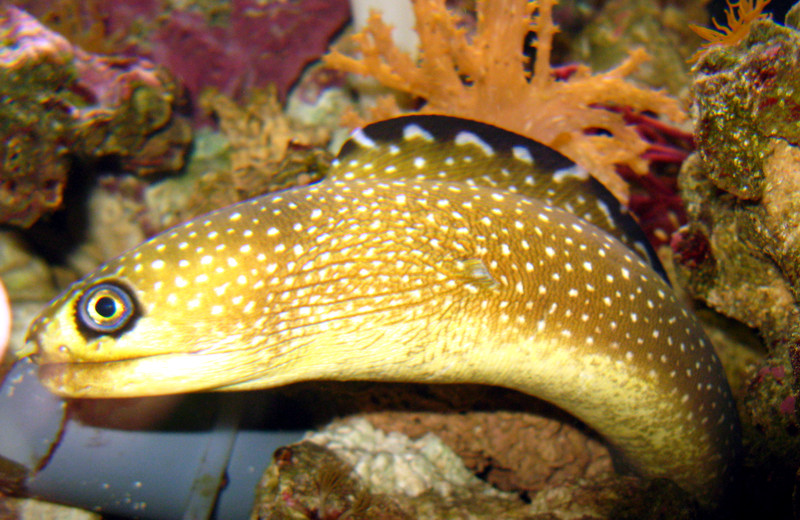
"The flesh of this Brazilian ocellated moray Gymnothorax ocellatus
contains thiaminase. Makes a better pet fish than food fish, anyway!"
Species that do not contain
thiaminaseFreshwater fish
Family Centrarchidae (North American Sunfishes):
Largemouth bass (Micropterus salmoides)
Northern rock bass (Ambloplites rupestris)
Northern smallmouth bass (Micropterus dolomieu)
Blue gill (Lepomis macrochirus)
Black crappie (Pomoxis nigromaculatus)
Pumpkinseed (Lepomis gibbosus)
Family Percidae (Perches):
Yellow perch (Perca flavescens)
Walleye (Sander vitreus)
Family Salmonidae (Salmonids):
Bloater (Coregonus hoyi)
Lake trout (Salvelinus namaycush)
Rainbow trout (Oncorhynchus mykiss)
Other families:
Ayu (Plecoglossus altivelis) - family Plecoglossidae (Ayu fish)
Longnose gar (Lepisosteus osseus) - family Lepisosteidae (Gars)
Northern Pike (Esox lucius) - family Esocidae (Pikes)
Brackish (freshwater to marine) fish
Family Salmonidae (Salmonids):
Cisco, Lake herring (Coregonus artedi)
Atlantic Salmon (Salmo salar)
Coho salmon (Oncorhynchus kisutch)
Sea trout (Salmo trutta)
Other families:
Common eel (Anguilla anguilla) - family Anguillidae (True eels)
Pond smelt (Hypomesus olidus) - family Osmeridae (Smelts)
Marine fish
Family Pleuronectidae (Righteye flounders):
Winter flounder (Pseudopleuronectes americanus)
Winter flounder, Lemon sole (Pseudopleuronectes americanus)
American plaice (Hippoglossoides platessoides)
Yellowtail flounder (Limanda ferruginea)
Atlantic halibut (Hippoglossus hippoglossus)
European plaice (Pleuronectes platessa)
Family Gadidae (Cods and haddocks)
Atlantic cod (Gadus morhua)
Haddock (Melanogrammus aeglefinus)
Saithe, Pollock (Pollachius spp.)
Family Sciaenidae (Drums or croakers):
Atlantic croaker (Micropogonias undulates)
Southern kingfish (Menticirrhus americanus)
Spot croaker (Leiostomus xanthurus)
Silver seatrout (Cynoscion nothus)
Sand weakfish (Cynoscion arenarius)
Family Carangidae (Jacks):
Greater amberjack (Seriola dumerilii)
Yellowtail scad (Atule mate)
Mackerel scad (Decapterus pinnulatus)
Family Labridae (Wrasses):
Cunner (Tautogolabrus adspersus)
Tautog (Tautoga onitis)
Family Scombridae (Mackerels, tunas, bonitos):
Atlantic mackerel (Scomber scombrus)
Kawakawa (Euthynnus affinis)
Other families:
Tusk (Brosme brosme) - family Lotidae (Hakes and burbots)
Largehead hairtail (Trichiurus lepturus) - family Trichiuridae
(Cutlassfishes)
Piked dogfish (Squalus acanthias) - family Squalidae (Dogfish
sharks)
Hake (Urophycis spp.) - family Phycidae (Phycid hakes)
Inshore lizardfish (Synodus foetens) - family Synodontidae
(Lizardfishes)
Mullet (Mugil spp.) - family Mugilidae (Mullets)
Scup, Southern porgy (Stenotomus chrysops) - family Sparidae
(Porgies)
Ocean perch, redfish (Sebastes marinus) - family Sebastidae
(Rockfishes)
Black seabass (Centropristis striata) - family Serranidae (Sea
basses and Groupers)
Hardhead sea catfish (Ariopsis felis) - family Ariidae (Sea
catfishes)
Searobin (Prionotus spp.) - family Triglidae (Searobins)
Silver hake (Merluccius bilinearis) - family Merlucciidae
(Merluccid hakes)
Eyestripe surgeonfish (Acanthurus dussumieri) - family
Acanthuridae (Surgeonfishes)
Atlantic blue marlin (Makaira nigricans) - family Istiophoridae
(Billfishes)
Blotcheye soldierfish (Myripristis berndti) - family
Holocentridae (Squirrelfishes, soldierfishes)
Glasseye (Heteropriacanthus cruentatus) - family Priacanthidae
(Bigeyes or catalufas)
Great barracuda (Sphyraena barracuda) - family Sphyraenidae
(Barracudas)
Invertebrates
Bivalves:
Cockle (Cardium spp.)
Crustaceans:
Marine shrimps (sp. indet.; Hawaii)
Portuguese crabs (sp. indet.)
Cephalopods:
Brief squid, calmar (Lolliguncula brevis)
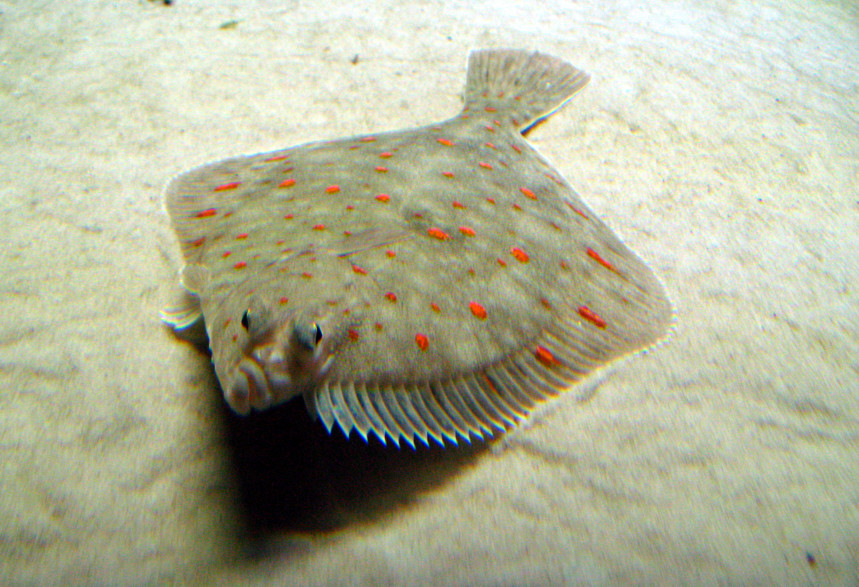
"All so far
examined flatfish like this European plaice (Pleuronectes platess)
are free of thiaminase."
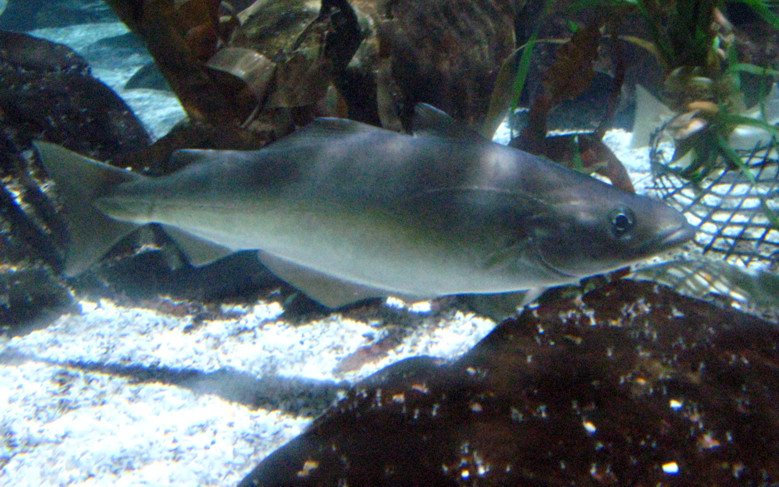
"So far examined fishes from the family Gadidae like this Pollock (Pollachius
pollachius) are free of thiaminase and a good choice for pet fish
nutrition."
What to do with fishes not mentioned in the lists above?
Certainly not every fishy food is included in the lists above. For many
food items probably no data exists, yet. What you can do if you are
missing a food fish in the list is:
1. Find out the scientific name of the food fish and compare it to the
list again. Many fish are traded under obscure names.
2. Try checking literature for the food species yourself. Search engines
are your friends. (If you are successful, reporting it back could help
other hobbyists).
3. If you fail to find information, treat the fish in question as if it
contained thiaminase.
What obviously won’t always work is to see if the fish in question
belongs to the same genus or family as one or more of the fish enlisted
(e.g. with fishbase.org). Related fish from the same genus or family may
have a similar composition in terms of protein or fat, but the
thiaminase content sometimes seems to vary greatly even between species
within a single genus, and may even vary from population to population.
Little or nothing is known about the thiaminase content of some of the
small ornamental fishes usually used as feeders. However, goldfish and
minnows (including rosy red minnows) definitely contain thiaminase and
consequently make very poor choices as feeders. On the other hand, the
Poeciliidae (e.g., guppies, mollies, mosquitofish) are often recommended
as safe feeder fishes for predators because of their presumed to be low
thiaminase content. Despite claims among aquarists that guppies contain
thiaminase producing bacteria, I am not aware of any scientific study
demonstrating this to be the case. Since poecilids are grazers, an
uptake of thiaminase-producing cyanobacteria would be possible, though
less probable in a freshwater aquarium where a much smaller variety of
algae are likely to be present than in the wild.
Anecdotal evidence that the notoriously delicate Ribbon Eel can live on
a diet of mostly gut loaded black mollies for more than 15 years would
seem to suggest that poeciliids are largely thiaminase-free and make a
safe choices for feeder fish. Of course this depends on the quality of
the feeder fish being used, and cheap feeder guppies from pet stores
might not contain any thiaminase but could certainly contain all sorts
of pathogenic bacteria and parasites! So when poeciliids are described
as being among the best feeder fish, this depends on them being bred at
home and gut loaded with Vitamin B1-enriched foods, such as a good
quality flake food. Because poeciliids have a high tolerance for
saltwater (mollies in particular can be maintained indefinitely under
marine conditions) they are equally useful in saltwater tanks as in
freshwater aquaria. But this said, avoidance of feeders is the best
option in terms of cost, convenience and safety, and the use of feeders
should be limited to those few obligate piscivores that will not take
dead food or for the acclimation of newly introduced livestock prior to
being trained to accept dead or frozen foods.
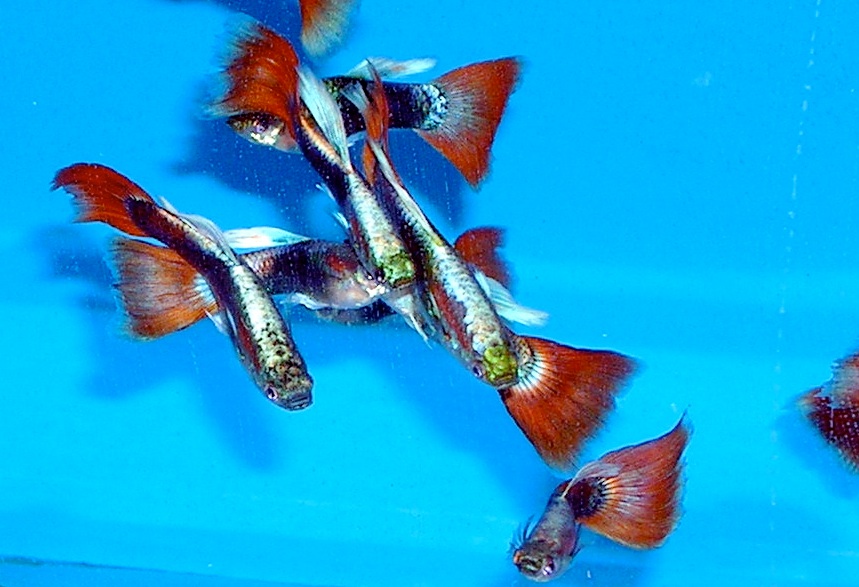
“The thiaminase content of guppies is
unknown, but considered low or negligible, making them much safer to use
than goldfish or minnow feeders.”
How can I avoid the thiamine deficiency syndrome?
Prevention is the best way to “treat” the thiamine deficiency syndrome.
Things to avoid include:
1. Restrict feeding thiaminase containing fish to no more than 20%
of all meals.
2. Avoid feeding exclusively frozen bivalves or shrimps, because
these potentially have very high thiaminase content.
3. Avoid fish that was frozen for long periods (several months).
Things to do:
1. Keep the diet generally as varied as possible! Remember,
nutritional shortcomings in one type of food will be cancelled out by
the other types of food, so the more types of food, the smaller the
chance of nutrient imbalances.
2. Soak food in a vitamin product intended for pet fish prior to
feeding at least once a week, more often when feeding lots of shrimps
and bivalves!
3. Get small packages of food, and use them up quickly.
Final words
Thiaminase-containing food will not be instantly lethal to your pets,
but over the long term can result in a slow decline in health. Simple
measures and a little conscientiousness when buying and preparing food
is all that is needed to easily avoid Thiamine Deficiency Syndrome.
References
Anglesea, J.D. & Jackson, A.J. (1985): Thiaminase activity in fish
silage and moist fish feed. Anim. Feed Sci. Tech. 13: 39-46.
Deutsch, H.F. & Hasler, A.D. (1943): Distribution of a Vitamin B1
destructive enzyme in fish.- Proc. Soc. Exp. Biol. Med. 53: 63-65.
Food and agriculture organization of the United Nations (1980):
ADCP/REP/80/11 - Fish Feed Technology. HYPERLINK
"http:]www.fao.org/docrep/X5738E/x5738e00.HTM#Contents"
http:]www.fao.org/docrep/X5738E/x5738e00.HTM#Contents
Greig, R.A. & Gnaedinger, R.H. (1971): Occurrence of thiaminase in some
common aquatic animals of the United States and Canada. Special
Scientific Report—Fish. U.S. Dept. Commer. Natl. Mar. Fish. Serv. 631:
1-7.
Hilker, D.M. & Peter, O.F. (1966): Anti-thiamine activity in Hawaii
fish.- J. Nutr. 89(4):419-421.
National Research Council (1981): Nutrient Requirements of Cold-water
Fishes. Washington, D.C.: National Academy Press.
National Research Council (1982): Nutrient Requirements of Mink and
Foxes, Washington, D.C.: National Academy Press.
National Research Council (1983): Nutrient Requirements of Warm-water
Fishes and Shellfishes. Washington, D.C.: National Academy Press.
National Research Council (1993): Nutrient Requirements of Fish.
National Academy Press. Washington DC, USA.
Royes, J.-A.B. & Chapman F.A.: Preparing your own fish feeds.-
University of Florida, 9 p. HYPERLINK
"http:]edis.ifas.ufl.edu/pdffiles/FA/FA09700.pdf"
http:]edis.ifas.ufl.edu/pdffiles/FA/FA09700.pdf
Scardi, V. & Magri, E. (1957): Thiaminase activity in Mytilus
galloprovincialis.- Boll Soc Ital Biol Sper. 33(7):1087-1089 (in
Italian).
Wistbacka, S.; Heinonen, A.; Bylund, G. (2002): Thiaminase activity of
gastrointestinal contents of salmon and herring from the Baltic Sea.-
Journal of Fish Biology 60(4), 1031-1042.
Yudkin, W.H. (1949): Thiaminase, the Chastek-paralysis factor.- Physiol.
Rev. 29: 389-402.
|
